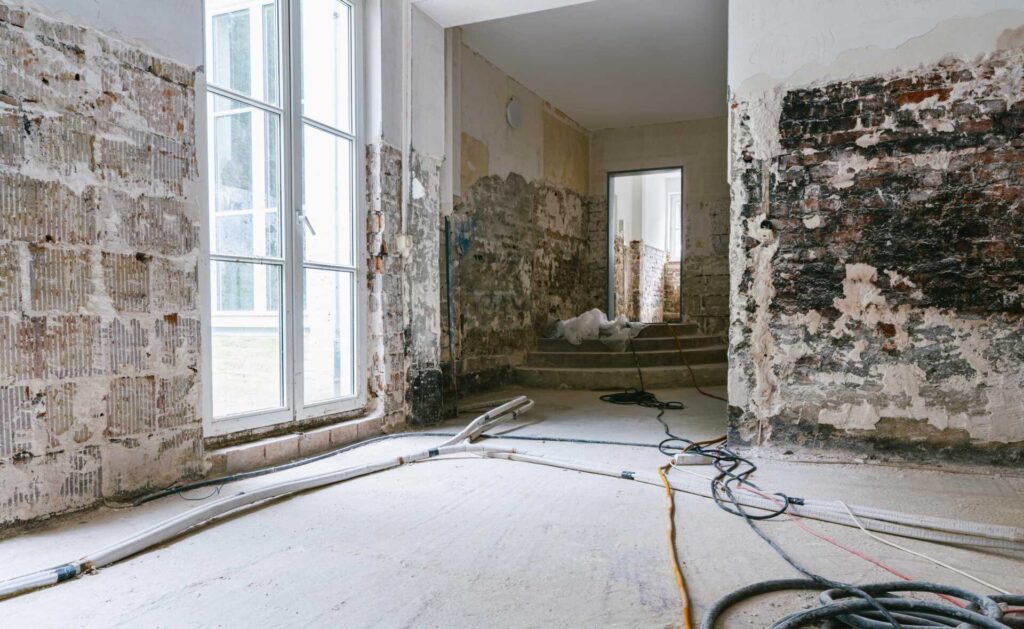
Contents
When mold creeps into your home like a silent intruder, swift action is key to safeguarding your health and property. From identifying the telltale signs to executing effective removal techniques, steering through an emergency mold situation requires a blend of caution and competence. By mastering the essential steps to combat mold growth, you can reclaim your space and ensure a healthier living environment for you and your loved ones.
Key Takeaways
- Conduct regular visual inspections in moisture-prone areas for mold growth.
- Use proper protective gear: gloves, goggles, and masks during mold removal.
- Isolate affected areas to contain mold spores and prevent spread.
- Employ natural cleaning solutions like vinegar and hydrogen peroxide.
- Ensure quick drying with fans, dehumidifiers, and proper ventilation.
Identifying Mold Growth Quickly
To effectively tackle mold issues in your home, it’s essential to swiftly identify any signs of mold growth. Mold detection is a vital step in maintaining a healthy living environment for you and your loved ones.
Regular visual inspections in areas prone to moisture, such as bathrooms, kitchens, basements, and around windows, can help you spot mold growth early on. Look out for any discoloration on walls, ceilings, or surfaces and musty odors, which are common indicators of mold presence.
During your visual inspection, pay close attention to any water leaks, condensation build-up, or areas with poor ventilation, as these conditions create a favorable environment for mold to thrive.
Remember that mold can grow on various surfaces, including drywall, wood, carpeting, and even fabrics, so be thorough in your examination. If you notice any suspicious signs, it’s important to address the issue promptly to prevent further spread and potential health risks.
Safety Precautions and Protective Gear
Rapidly identifying mold growth in your home is vital for effectively managing any mold issues.
When it comes to mold removal, safety precautions and protective gear are paramount. Mold exposure can lead to various health risks, including respiratory issues, skin irritation, and allergic reactions. To protect yourself, make sure you have the proper equipment before starting the removal process.
Ventilation strategies play an important role in minimizing exposure to mold spores. Before beginning any removal work, open windows and use fans to improve air circulation in the affected area. This helps reduce the concentration of mold spores in the air, lowering the risk of inhalation.
When dealing with mold, always wear protective gear such as gloves, goggles, and a mask. Gloves shield your skin from direct contact with mold, goggles protect your eyes from irritants, and a mask prevents you from inhaling spores.
Additionally, wear long sleeves and pants to cover your skin fully.
Containment of Mold Spores
Proper containment of mold spores is vital during the removal process to prevent further spread and recontamination of the area.
When dealing with mold spore containment, follow these important steps:
- Isolate the Affected Area: Seal off the contaminated space using plastic sheeting and duct tape to prevent mold spores from dispersing to other parts of the house.
Make sure all windows and doors are securely closed during remediation.
- Utilize Air Filtration Systems: Employ air scrubbers equipped with High-Efficiency Particulate Air (HEPA) filters to trap mold spores and other particles in the air.
This helps improve indoor air quality and prevents the spread of mold to uncontaminated areas.
- Establish Negative Air Pressure: Use fans to vent air outside to set up a containment area with negative air pressure.
This system ensures that any airborne mold spores are directed outside rather than circulating within the home.
Effective Mold Cleaning Techniques
Once the containment of mold spores is secured, the focus shifts to implementing effective mold cleaning techniques. Identifying the type of mold present is vital before proceeding with cleaning. You can use mold identification methods such as visual inspection, tape lift samples, or air sampling to determine the specific type of mold in your home.
Now, let’s explore the cleaning process. When dealing with mold, opting for natural cleaning solutions can be effective and safe for you and the environment. Ingredients like vinegar, hydrogen peroxide, baking soda, and tea tree oil are known for their mold-fighting properties. These natural solutions not only help in removing mold but also prevent its regrowth.
Begin by preparing your chosen natural cleaning solution and applying it to the affected areas. Use a scrubbing brush or sponge to gently scrub the mold-infested surfaces. Remember to wear protective gear such as gloves, goggles, and a mask to avoid exposure to mold spores.
After cleaning, dry the area thoroughly to prevent moisture buildup, which can lead to mold growth.
Drying and Dehumidification Methods
To effectively combat mold growth, you must utilize quick-drying techniques in areas prone to moisture buildup.
Implementing the use of dehumidifiers is essential in maintaining ideal indoor humidity levels, preventing mold from thriving in damp environments.
Quick Drying Techniques
Utilizing quick-drying techniques is essential for effective mold removal. Ensuring that the affected areas are dried promptly is vital to prevent further spread and damage when dealing with mold growth.
Here are some quick-drying techniques to aid in your mold removal efforts:
Increase Air Circulation: Place fans strategically around the affected area to improve air circulation. This helps speed up the drying process and inhibit mold growth.
Use Dehumidifiers: Employ dehumidifiers to reduce excess moisture in the air, creating an environment less conducive to mold growth.
Open Windows and Doors: Allowing fresh air to flow through the space can help in drying out the area faster. This also aids in ventilating the space and improving overall air quality.
Importance of Dehumidifiers
Efficient mold removal relies heavily on the utilization of dehumidifiers as part of the drying and dehumidification methods. Dehumidifiers are essential in controlling humidity levels within your home, preventing mold growth, and aiding in the drying process.
By reducing the moisture in the air, dehumidifiers create an inhospitable environment for mold spores, inhibiting their proliferation.
To effectively use dehumidifiers in mold removal, guarantee proper air circulation throughout the affected area. Position the dehumidifier in a central location to maximize its reach and effectiveness. Additionally, regularly empty the water collection trays to prevent the buildup of excess moisture in the unit.
Humidity control is key to combating mold, and dehumidifiers are valuable in achieving this. Investing in a high-quality dehumidifier can greatly aid in mold removal efforts and help maintain a healthy indoor environment.
Preventing Future Mold Growth
One essential aspect of maintaining a mold-free home is implementing proactive measures to prevent future mold growth.
To ensure your home remains a safe and healthy environment for you and your family, consider the following preventive actions:
- Utilize Mold Resistant Materials: When renovating or updating your home, opt for mold-resistant materials such as mold-resistant drywall, paints, and insulation.
These materials are designed to inhibit mold growth, reducing the chances of mold developing in your home.
- Improve Ventilation Systems: Proper ventilation is key to preventing excess moisture buildup, which can lead to mold growth.
Make sure that your home has adequate ventilation in areas prone to moisture, such as bathrooms, kitchens, and basements.
Consider installing exhaust fans or dehumidifiers to keep humidity levels in check.
- Regular Maintenance: Stay vigilant with regular home maintenance tasks to prevent mold growth.
Check for leaks in pipes, roofs, or windows and repair them promptly.
Keep an eye on areas where moisture tends to accumulate and address any issues immediately to prevent mold from taking hold.
Recap
Homeowners facing mold emergencies must act swiftly and effectively to mitigate health risks and prevent structural damage. Indoor mold can start growing within 24-48 hours of a water intrusion, highlighting the importance of quick mold removal. By following the essential techniques outlined in this article, you can effectively address mold issues and create a safe, mold-free environment in your home.
Recent Posts
7 Best Storm Damage Repair and Mold Control Tips
You may not realize that storm damage can lead to hidden mold growth, posing health
How to Prevent Mold After Flood Damage
When faced with flood damage, preventing mold is paramount. Acting swiftly to eliminate excess water
Top 10 Tips for Flood Repair and Mold Prevention
When faced with the aftermath of a flood, steering through the waters of repair and
